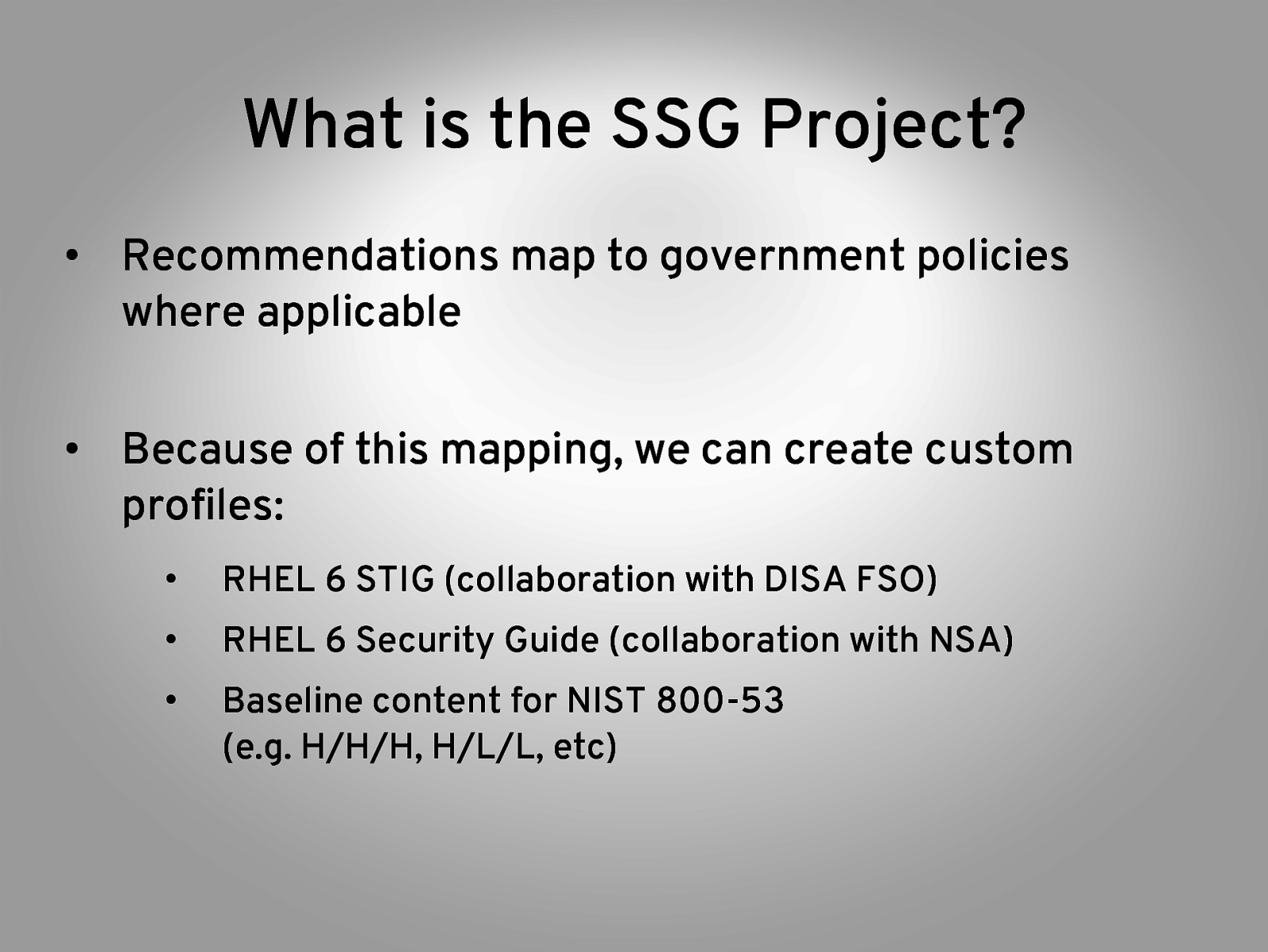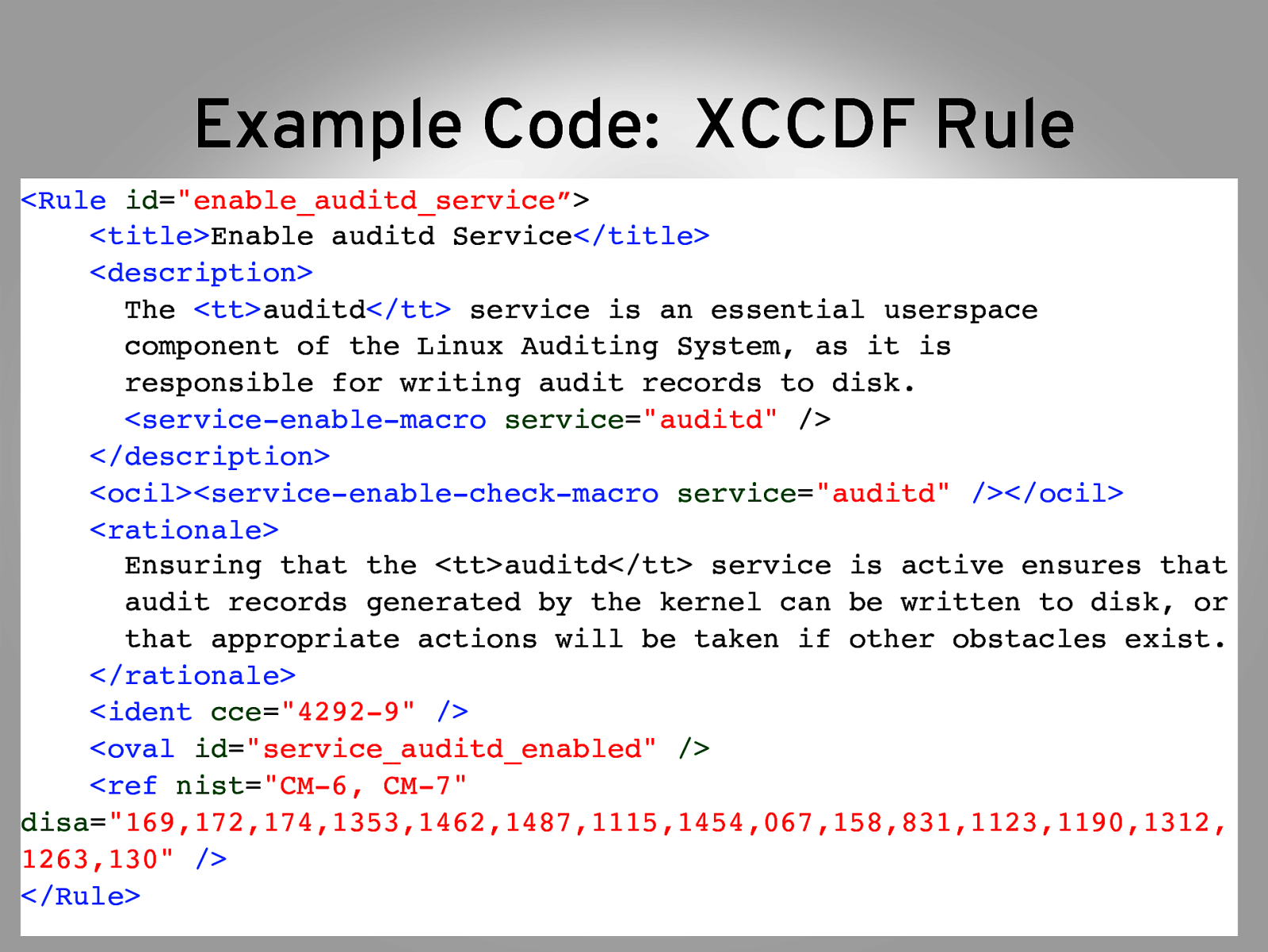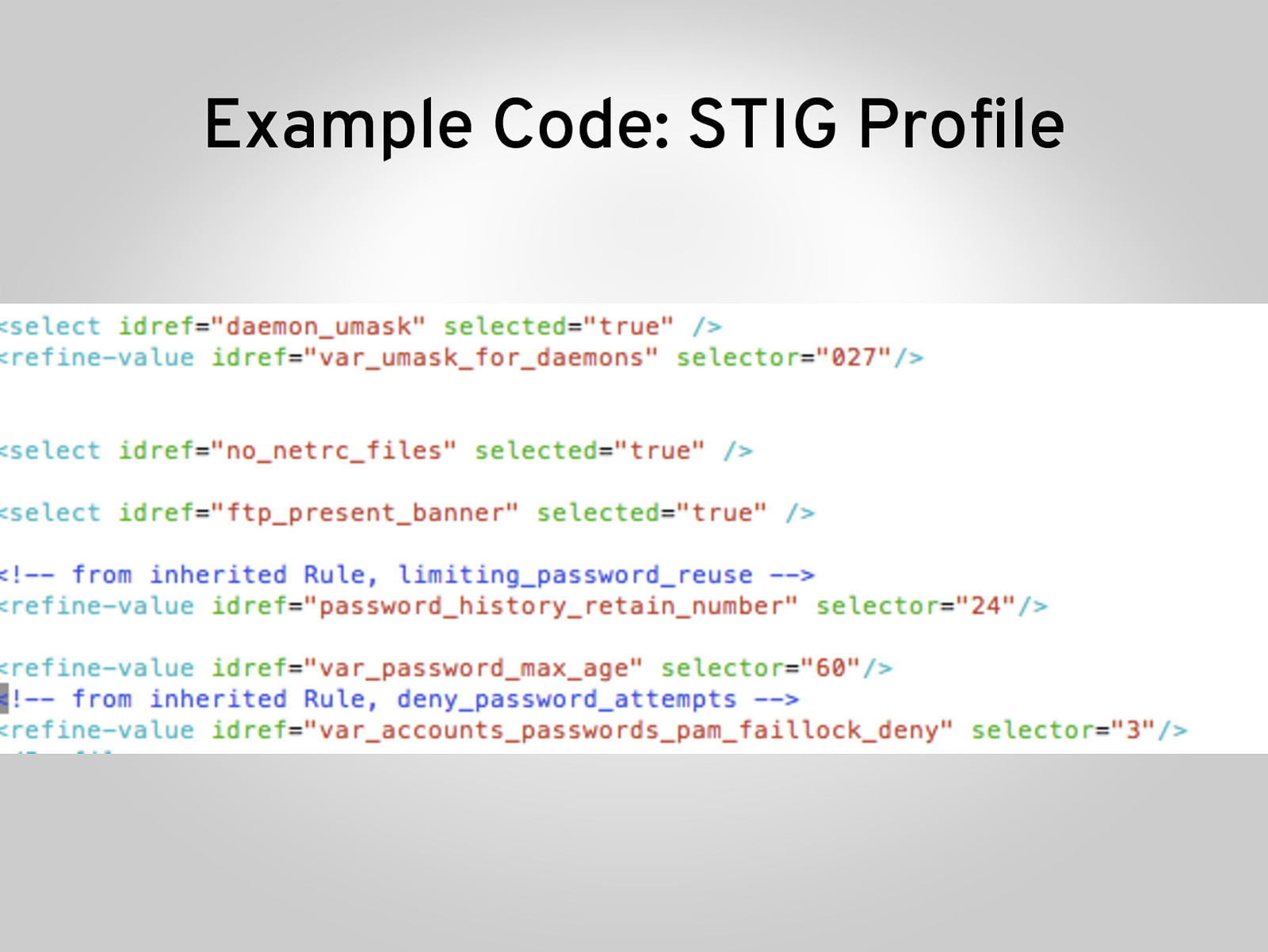SCAP Security Guide https://fedorahosted.org/scap-security-guide/ SHAWN WELLS shawn@redhat.com (+1) 443-534-0130 THIS BRIEFING IS UNCLASSIFIED 1
Slide 1

Slide 2

What is the SSG Project? - Delivers practical security guidance, baselines, and associated validation mechanisms using the Security Content Automation Protocol (SCAP) - Current content for RHEL 6, JBoss EAP5
- Upstream source for government implementation guidance moving forward - JBoss Enterprise Application Platform 5 STIG - Red Hat Enterprise Linux 6 STIG, SNAC Guide, NIST 800-53 baselines
Slide 3

What is the SSG Project? • Recommendations map to government policies where applicable • Because of this mapping, we can create custom profiles: • RHEL 6 STIG (collaboration with DISA FSO) • RHEL 6 Security Guide (collaboration with NSA) • Baseline content for NIST 800-53 (e.g. H/H/H, H/L/L, etc)
Slide 4

Who is the SSG Project?
Slide 5

Slide 6

Step 1: Download the Code 1. Download required packages: # yum install git openscap-utils python-lxml ” 2. Grab the latest code (…eventually we will have release RPMs): $ cd /tmp/ $ git clone \ git://git.fedorahosted.org/scap-security-guide.git ” 3. Run make $ cd /tmp/scap-security-guide/; make all”
Slide 7

Step 2: Review Human Readable Outputs 1. Review prose guide $ firefox /tmp/scap-security-guide/RHEL6/output/rhel6guide.html” - Reads like NSA SNAC Guide - Includes all controls ” 2. Review RHEL6 STIG candidate $ firefox /tmp/scap-security-guide/RHEL6/output/tablerhel6-stig-server-shorttitles.html” - Includes manual check details (OCIL text) - Using DoD Consensus process with Red Hat, NSA, DISA FSO - RHEL6 STIG by Christmas?” 3. Notice the last column! Mappings back to CCI, NIST 800-53…. foundations of automatically generated SRTM”
Slide 8

Step 3: Review the XCCDF (“Prose Code”) 1. XCCDF: Fancy way of saying XML-ized prose $ cd /tmp/scap-security-guide/RHEL6/input/ $ vim system/auditing.xml /enable_auditd_service” 2. Notice the structure Rule ID’s Random name for the rule, machine readable Title Human name Description Tells how to meet rule OCIL How to manually verify compliance Rationale Describes why the rule is important IDENT Unique identifier for CCE’s OVAL ID Maps back to an OVAL check, the machine language for automated compliance language REF We made this up, to create correlations back to policy documents
Slide 9

Example Code: XCCDF Rule <Rule id=”enable_auditd_service”> <title>Enable auditd Service</title> <description> The <tt>auditd</tt> service is an essential userspace component of the Linux Auditing System, as it is responsible for writing audit records to disk. <service-enable-macro service=”auditd” /> </description> <ocil><service-enable-check-macro service=”auditd” /></ocil> <rationale> Ensuring that the <tt>auditd</tt> service is active ensures that audit records generated by the kernel can be written to disk, or that appropriate actions will be taken if other obstacles exist. </rationale> <ident cce=”4292-9” /> <oval id=”service_auditd_enabled” /> <ref nist=”CM-6, CM-7” disa=”169,172,174,1353,1462,1487,1115,1454,067,158,831,1123,1190,1312, 1263,130” /> </Rule>”
Slide 10

Step 3: Review the OVAL (“Scanning Code”) OVAL == Open Vulnerability and Assessment Language Three primary purposes:
- Represent configuration information of systems for testing; - Analyzing the system for the presence of specified machine state - Reporting results
- Review the code $ cd /tmp/scap-security-guide/RHEL6/input/ $ vim checks/sysctl_net_ipv6_disabled.xml “
- Notice the structure <affected> ind:textfilecontent54_testind:textfilecontent54_object What OS’s to perform the check on Outlines conditions for the test, points to “object” Spells out what to check for
Slide 11

Example Code: OVAL Check <ind:textfilecontent54_object id=”obj_20134” version=”1”>” ind:path/etc</ind:path>” ind:filenamesysctl.conf</ind:filename>” <ind:pattern operation=”pattern match”>^\snet.ipv6.conf.all .disable_ipv6\s=\s*1$</ind:pattern>” <ind:instance datatype=”int”>1</ind:instance>” </ind:textfilecontent54_object>”
Slide 12

Step 4: Review Profiles • As a body of work, SSG represents a catalog of recommendations • Not all recommendations are applicable to everyone, so we create or logical groupings of rules called “Profiles,” e.g.: • Red Hat Enterprise Linux 6 STIG • Red Hat Enterprise Linux 6, NIST 800-53 H/L/L
- Review the code $ cd /tmp/scap-security-guide/RHEL6/input/profiles/ $ vim STIG-server.xml “
- Notice the structure <select idref> <refine-value> Pulls in the rule For some things we included variable substitution to allow for customizations, e.g. length of passwords (vim: /var_password_max_age)
Slide 13

Example Code: STIG Profile
Slide 14

Step 5: Run a Scan • Guide online at https://fedorahosted.org/scap-security-guide/wiki/usageguide 1. Some checks require root access $ sudo su -” 2. Run a scan for STIG compliance # cd /tmp/scap-security-guide/RHEL6/output # oscap xccdf eval —profile stig-server ssg-rhel6-xccdf.xml”
Slide 15

Step 6: DEVELOPER PREVIEW of <fix> tags • The protocol also supports inclusion of remediation scripts • Eventually, we’ll merge in bash and puppet remediation. When we do this depends on how loudly people scream for it. • Development done under RHEL6/input/fixes (not much there as of 16-OCT-2012, patches welcome!)